Eastern Croatia Attracts Increasing Number of Domestic Tourists
April 17, 2022 – Good news coming from eastern Croatia, with trends showing an increased interest of domestic tourists in the golden fields, fiery stews, and the sweetest wines of Slavonia.
As hrv.hr writes, last year's trend of increasing the number of overnight stays in eastern Croatia continues this year as well.
According to the Vukovar-Srijem County Tourist Board (TZ VSŽ) for the first three months of this year, the number of overnight stays in this part of Croatia increased by more than 40 percent compared to the same period last year.
Most of the guests are domestic tourists who have had a positive impact on the county's tourist results with their arrivals and overnight stays, and it is evident that their interest in the eastern part of Croatia is finally stable and growing.
According to the director of the Vukovar-Srijem County Tourist Board, Rujana Bušić Srpak, the results of the first quarter, but also the whole of last year, show that tourism can be maintained even in crises such as a pandemic.
“It is important to emphasize that the survival of tourism in the continental part of Croatia should be credited to domestic guests. They are in our focus, and they are the ones who can maintain the tourist movement even in crises, revive the tourist potential, and stimulate the domestic economy. The majority of our guests come from Croatia, and almost half of them are from Zagreb and the Zagreb County”, says Rujana Bušić Srpak, adding that in the wave of current price increases, the county still has affordable prices and provides excellent value for money.
For more, check out our lifestyle section.
Contents of a Slavonian Easter Basket: From Eggs to Green Onions
15th of April 2022 - The most important Christian holiday is almost here which means plenty of food and traditions that have been part of Croatian culture for centuries are in focus. A look at the contents of a Slavonian Easter basket.
With Lent being over on Palm Sunday, Holy Week and the final days before Easter have begun. Of course, that means believers who participated in relinquishing and fasting during Lent can finally start eating normally, except on Good Friday when fasting is strictly prescribed. Preparations for Easter include a lot of cooking and preparing sweet pastries to celebrate Jesus’s resurrection. Good Thursday is dedicated to the remembrance of Christ’s Last dinner and no one can work on their soils or crops. As already mentioned, Good Friday includes a strict fast with only one proper meal allowed, which symbolizes Jesus’s torment and death. After Good Friday, Good Saturday is reserved for silence and preparations of said meals that have everything from heavy meat to spring vegetables and more. However, the most important part of the Easter celebration is definitely an Easter basket, which contains a variety of foods reserved for blessing and later for Easter celebration, most commonly as a breakfast on Easter itself.
Easter Eggs
Most things in the basket are definitely Easter eggs (pisanice), or boiled chicken eggs with beautiful handmade designs that differ from family to family. This custom of decorating and gifting eggs was known throughout Europe, especially among Germans, Scandinavians, and Slavs. Even its age is confirmed by archeological grave finds. When it comes to Christianity, the egg is a symbol of the new and eternal life that Jesus made possible for people through the resurrection. In Croatian traditional culture, the custom has remained to this day. In the past, only domestic homemade colors were used for painting eggs and they were obtained from broccoli, onion peel, nettle, various grasses, and many more. Aniline dyes became popular much later. Wax was applied to the egg by a special funnel-shaped pen or pinhead; this technique also made it possible to obtain multicolored ornament. These traditional ways of painting Easter eggs came back - more and more people fall back to old customs because of healthy and more organic ways of painting. On Easter morning, eggs are put to use - children break eggs to determine who has the strongest one.
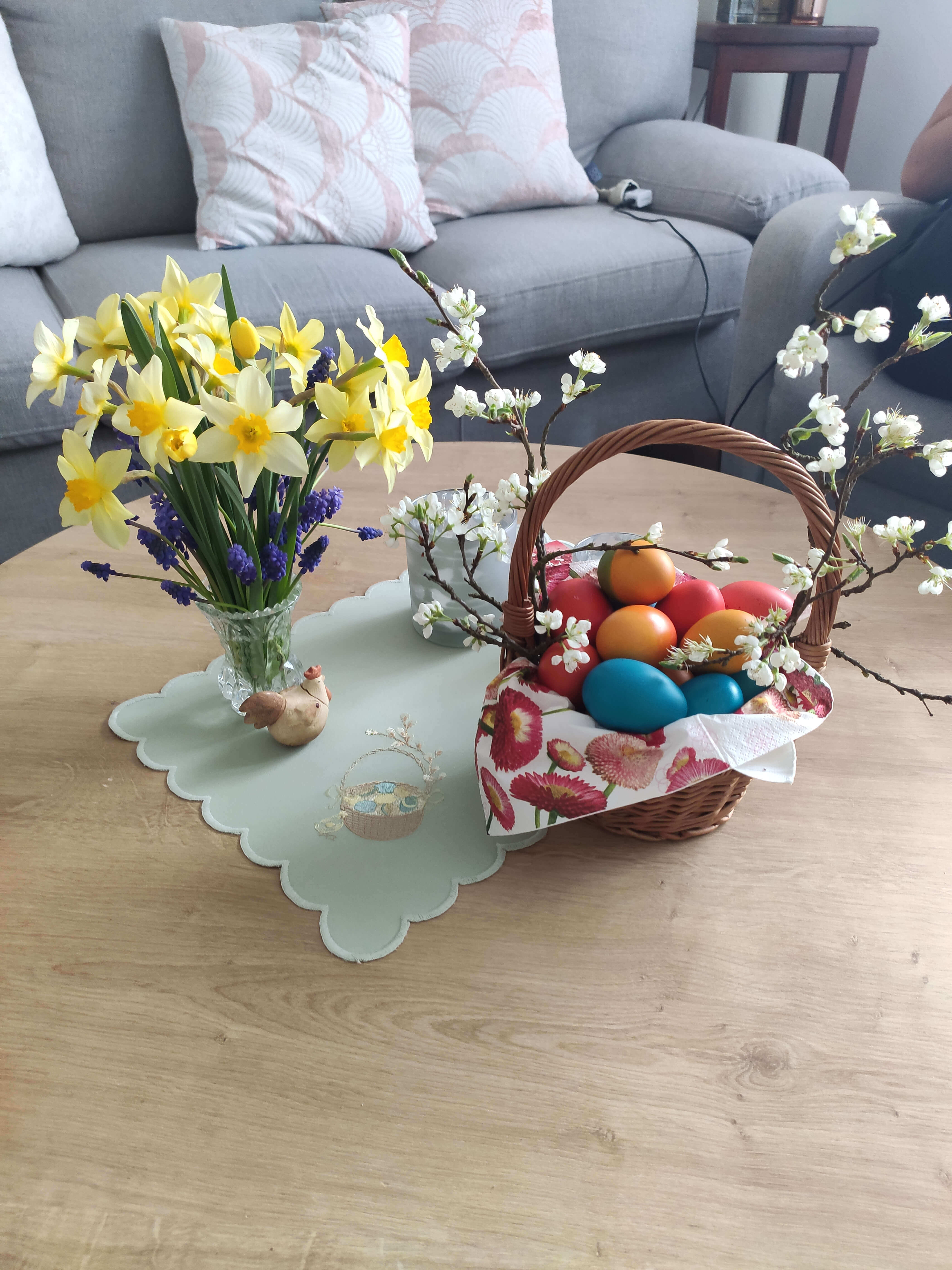
Colored Easter eggs and spring flowers on Easter (photo credit: Private album)
Unleavened bread
As we know a lot of Christian traditions are shared with Jewish customs and unleavened bread is part of that as well. It symbolizes Christ’s body and according to Bible, was present at Christ’s Last dinner. There are a lot of variations of bread throughout Croatia like normal pogača, pinca, however, unleavened bread is a customary Easter bread in Slavonia and represents sacrifice. Its texture is somewhere between hard and soft and has a neutral flavor which fits amazingly well with other Easter basket components.
If you’re interested in making this bread, here is my family’s recipe that’s been used every Easter for decades:
0,5 kg of smooth flour
1 package of baking powder
1 teaspoon of salt
4 egg yolks
1 egg
1 tablespoon of pork lard
10 dag of butter
Method:
Mix with milk so that it is neither soft nor hard. Let it sit for 10 minutes, after that put it in a small bowl with a diameter of 18 cm. Grease the bread really well with lard and put the bread in the oven preheated to 180°C. Bake it for 30 minutes, take it out, coat it with egg yolk and milk mixture using a brush, put it back in the oven, reduce the temperature to 150°C and bake it for 25 minutes more.
There you go! You have a proper Slavonian bread that’s part of every Easter basket.

Easter breakfast with food from Easter basket (photo credit: Private album)
Ham
Fragrant-cooked ham is certainly the main star of the Easter table and what evaluates the quality of its preparation is juiciness. The type of meat is really important but the best is definitely pork meat or rather pork leg which is considered the “real” ham. Other than classic cooked ham that we know and love, there is an alternative - ham wrapped in pastry. Again, its preparation varies from family to family and the quality of the meat is determined by the financial status of the people who prepare it.
If you’re interested in the preparation of cooked Easter ham, check this recipe here.
Radish
The so-called spring queen of health and a vitamin bomb. Although radish is primarily associated with the Easter table, many people buy this vegetable because of its rich nutritional composition and medicinal properties. Indispensable food of every Slavonian Easter basket.
Green onion
If it's planted before Spring, green or young onions are definitely an unavoidable vegetable for the Easter basket. Strong, spicy, and its intensive smell with ham bring something really special to every Slavonian household on Easter. Like radish, it is a great ingredient in a variety of Easter salads.
Sweet cakes and pastries
Last but not least, cakes and pastries are a must in every Slavonian Easter basket. From usual pies like cakes like mađarica, chocolate pie, white pie, honey pie, so-called Katherine (Katarina kolač), and coconut-walnut cubes that were and still are a staple for Slavonian desserts through decades, small cakes, pastries, and cookies are getting more and more popular in recent years. Likes of išleri, baskets (košarice), rum balls, linzers, triangles and so many more. Cherry or apricot strudel is also a recent pastry baked and consumed on Easter. Breskvice (peaches) as well - signature Slavonian cake.
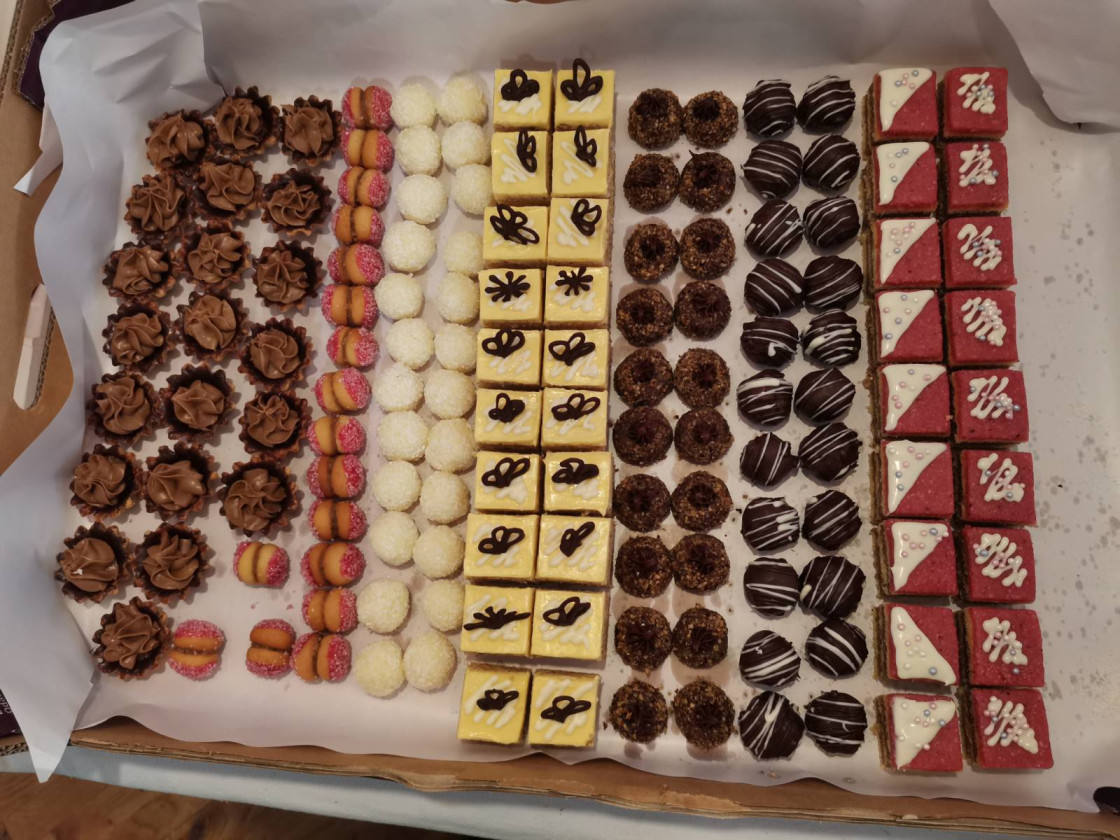
Sweet cakes and popular pies in Slavonia (photo credit: Private album)
Salt is also part of the blessed Easter basket with candles that will be lit on Easter breakfast and other various items that believers want to bless.
As said in the beginning, Easter is the most important Christian holiday. It celebrates Christ’s sacrifice and resurrection. Throughout the centuries, Croatians managed to save huge parts of their cultural and traditional heritage and it’s not a coincidence that Easter customs are one of the oldest traditional practices in Croatia’s history. It doesn’t matter if you’re not a believer, everyone is welcome to try the contents of a Slavonian Easter basket, take it, and in the end, try to make these delicious meals for themselves. At the end of the day, this is the time, not just for sacrifice, but for sharing and love as well.
Sretan Uskrs!
For more about lifestyle in Croatia, visit our dedicated TCN page.
Meet Vukovar 365, Full of Life – Tomislav and Mara of T&M
April 20, 2022 – The Vukovar business scene here always welcomes new and exciting ideas and products, but appreciates anything handmade, this time made by Tomislav and Mara Ozdanovac of T&M.
They are a young married couple from Vukovar who decided to invest their time, money, and a lot of work into what used to be a hobby yet fulfilled them on multiple levels. After years of careful consideration, saving, planning, and worrying, they finally decided to take the plunge and try and make a living producing wooden household and decorative items, as well as embroidery, both traditional and modern. Their business is still very young, but they are happy with how it’s taken off and feel motivated and inspired to keep going, doing what they do best. You can find them on Facebook, and here are some of their thoughts and opinions.
Tell us about your business, what do you do?
T&M opened a few months ago, headed by Tomislav and Mara Ozdanovac, a young married couple and parents of two girls. We make wooden products such as serving trays, boards, toys, shelves, etc. as well as chiffon and cotton embroidery.

Where did you get the idea and what makes your offer unique?
We decided to turn our previous hobbies into a business and thus bring our products closer to everyone at affordable prices. After a while, we decided to turn our thoughts and conversations into action, and one evening we sat down and created T&M.
What is unique is that we craft everything by hand, though a lot of things have been modernised and it’s possible to have it done by machines. You may have to wait longer for some products, but you can rest assured knowing that you are investing in handicrafts.
What was it like starting such a business in Vukovar? What were the main challenges?
We didn't have any major obstacles because we made sure to save up and acquire our own space and materials before we even started the business.
Do you think that the fact that you are in eastern Croatia influenced your success?
Yes, in a good way. Most of our products are bought outside our city and our county. This was greatly influenced by social networks and the purchasing power of the rest of our beautiful country. Other people tend to think that we are a poor, underdeveloped region, yet our people continue to prove them wrong with their effort and ideas, and we like to believe that so do we.
Are you happy with how your business is developing? What is your perspective for the future?
Seeing as we have only been open for a few months, we are very satisfied with the customer feedback and the number of orders we’ve received. You never know what the future holds. We are still a small business, but we hope that time will do its thing and that we will become recognized more widely, which gives us a lot of motivation for the future.

What opportunities are there in our city and region?
There are many small businesses and craftsmen in our area who work and strive to improve our living standards and the offer in this part of Croatia. The opportunities are many, it's just a matter of how many customers will recognize the work and the ideas behind it.
What is your view of other small businesses in Vukovar?
In principle, everyone works for themselves, but we support each other and encourage the growth and development of "the small ones".
Finally, tell us about life in Vukovar. What do you like most, what would you say to all potential visitors?
Vukovar is a city tailored to every person who appreciates peace, does not like crowds and the hustle and bustle of large urban areas. You will love the generosity and hospitality of our fellow citizens, nature, rivers, promenades, museums... We tell future visitors to enjoy our city and the benefits it provides because now they are numerous.
For more, check out our lifestyle section.
Good Friday With Fasting Meals For Citizens From 10 AM in Vinkovci
14th of April 2022 - The City of Vinkovci, the Independent Trade Union (DZZP) and the Vinkovci Technical School, along with the support of multiple companies from Vinkovci, have announced the distribution of fasting meals for all citizens on Good Friday.
As Novosti.hr writes, the now traditional event that occurs every Good Friday before Easter will have fish and potato salad on the menu this year as well. Future chefs, more precisely the students of the Vinkovci Technical High School will be in charge of preparing the food.
Mayor Ivan Bosančić will also take part and help in the morning food giveaway in front of the Vinkovci Gymnasium (School) from 10:00 on Vinkovci’s main square. He emphasised that meal itself is not the main motive for gathering people together, but that going out to the square and spending time together in the festive spirit is the point, as we celebrate the greatest Christian holiday, Easter.
Everyone is happy to respond when it comes to celebrating traditions like this - the Trade unionis, the City, various donors and of course, the hardworking student chefs who will prepare more than one thousand portions of meals for the occasion. Whether it’s Good Friday or Christmas Eve, a sense of togetherness is the most valuable part of it all.
Let us also remind ourselves that Good Friday is one of the two days of strict fasting in the liturgical year, with Ash Wednesday when Lent begins.
Fasting for Catholics means taking only one full meal a day as opposed to fasting when eating the usual three meals except meat. Strict fasting on Ash Wednesday and Good Friday isn't just fasting, but the practice of abstinence at the same time, which means believers on that day eat only one full, modest and simple meal to the brim. Good Friday is a day of renunciation and penance and in that sense, the meal served on the table should be exactly like that.
For more, check out our lifestyle section.
Traditional Festivities in Slavonia - Unmissable Events
7th of April 2022 - There are a lot of festivities you can visit in Slavonia - from beer and food festivals that became really popular in recent years, to modernized cultural manifestations which teach us something new. However, traditional festivities in Slavonia which are held for more than half a century, are still an irreplaceable staple of this region.
When reviewing the list of festivities in Croatia, a tourist or even a Croatian citizen, is shocked by the variety and content Croatia organizes every year for their visitors. Urban, cultural, and gourmand festivals are in forefront of most tours and offers, especially with summer coming soon and since Croatia became a really popular destination among tourists, they also got more interested in the tradition and cultural heritage of the region they visit. For instance, Dubrovnik, which is a jewel of the Adriatic coast, not only attracts visitors with its gourmand offers or beautiful historic sites like Tvrđava, they also have the Dubrovnik Summer Festival (Dubrovačke ljetne igre) which brings visitors closer to tradition and the way native people of Dubrovnik lived centuries ago. This event brings Dubrovnik back to the golden age of renaissance and baroque, the living spirit of drama and music, and many more, which were bestowed upon Croatian cultural and scholarly history. That’s why Dubrovnik is so good at tourist offers, they bring everything to everyone.
However, with different tourists comes different tastes and recent years showed an increase in interest in Eastern Croatia, more precisely, Slavonia and Baranja, which are labeled as more “rural, folk” regions. Slavonians and Baranians recognized the potential these regions have and started adapting to tourists' wishes and needs. Yes, they devised and organized multiple new festivals that will be held for many years to come but they realized their traditional festivals, which are really popular with lovers of everything related to tradition and locals, need more exposure.
Đakovački vezovi - Đakovo
Today, Đakovački vezovi is a well-known and affirmed manifestation of original folklore. The first manifestation occurred in July 1967, as part of then the International Year of Tourism and from the beginning, the event was a great success with people from Slavonia and beyond. The main event kept its original date and it’s held every year in July. Contents of the festival include original folklore from Slavonia, Baranja, Western Srijem, and other parts of Croatia with accompanying events such as the opening of various exhibitions, equestrian events, and other cultural and tourist events. The entire city participates in the event and in 2005, it received the International Tourism Charter (European Federation of Tourist Journalists based in Rome) Merits for Tourism. Thousands of folk costumes pulled from the chest of oblivion, thousands of participants from Slavonia, Baranja, the whole of Croatia, even Europe, and the world, bring us songs, dances, and customs of their homeland for decades in Đakovo. If you’re a gourmet, you’re settled. Hundreds of different dishes are served and ready for degustation. Wine lover? Multiple winemakers with their best wines are ready to show off their products which are a reflection of the beautiful, rich region of Slavonia. Artists, folk, history lovers, and even animal lovers can come and have the time of their lives which makes it one of the largest and most popular traditional festivities in Slavonia. For more details, check out their official website.
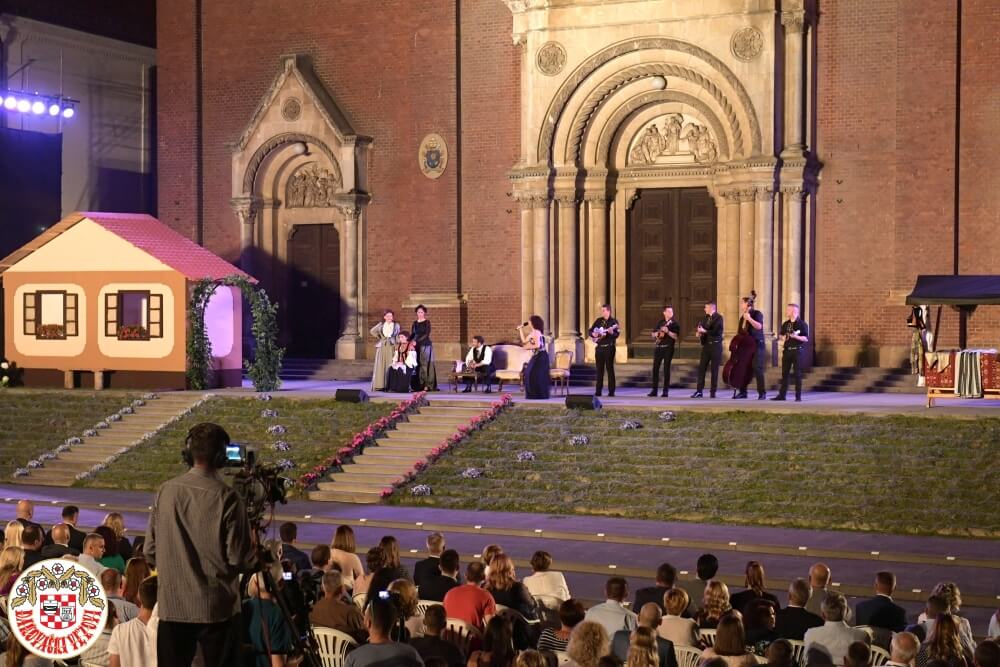
The opening of "Đakovački vezovi" in 2019 (photo credit: Photo Gallery - djakovacki-vezovi.hr)
Vinkovačke jeseni (Vinkovci Autumns) - Vinkovci
Definitely, the largest cultural event in the region, arguably in Croatia and some would say, in this part of Europe. The First Vinkovačke jeseni was organized in September 1966 and soon became one of the most famous festivals of its kind in all of Croatia. The foreground of the manifestation is the care of traditional folk dances, costumes, and customs in order to preserve various values of folk and traditional life of Slavonia. What’s really interesting is the fact that the manifestation is organized in September because of autumn - a season that rewards Slavonians for their hard work. After its founding, the festival soon began to connect all lovers of cultural heritage, not just Slavonia, but all the regions in Croatia. So every year hundreds of Folklore Societies from Croatia, Serbia, Bosnia and Herzegovina, Slovenia, and many more come to Vinkovci to display their culture to visitors. However, they didn’t stop there. Organizers recognized the tourist potential of their event and upgraded it for modern times, so apart from the main event which signifies a closure of Vinkovačke jeseni, the whole week before the opening is dedicated to its visitors! For instance, the opening of the event comes with a big performance by the local theatre with other guests from all over Croatia and in the evening the concerts of the biggest Croatian music stars begin, every evening of the week! Personally, I watched biggest Croatian performers on Vinkovačke jeseni stage like Dino Dvornik, Severina, Jelena Rozga, Klapa Intrade, Giuliano, Prljavo Kazalište and so many more. It truly is for everyone. Then, when the show of the manifestation ends on the last day of the week with the biggest folklore parade in this part of Europe (nationally televised), with the most popular folk and traditional commentator in Croatia, Branko Uvodić, every visitor feels enriched with Slavonian tradition, cultural heritage, food, art, folklore and more. That’s why Vinkovačke jeseni is one of the biggest traditional festivities in Slavonia and one of the best representatives of Croatian traditional, cultural heritage in this part of Europe. For more details, visit their official page. If you want to read more about Vinkovci, check this TCN article.
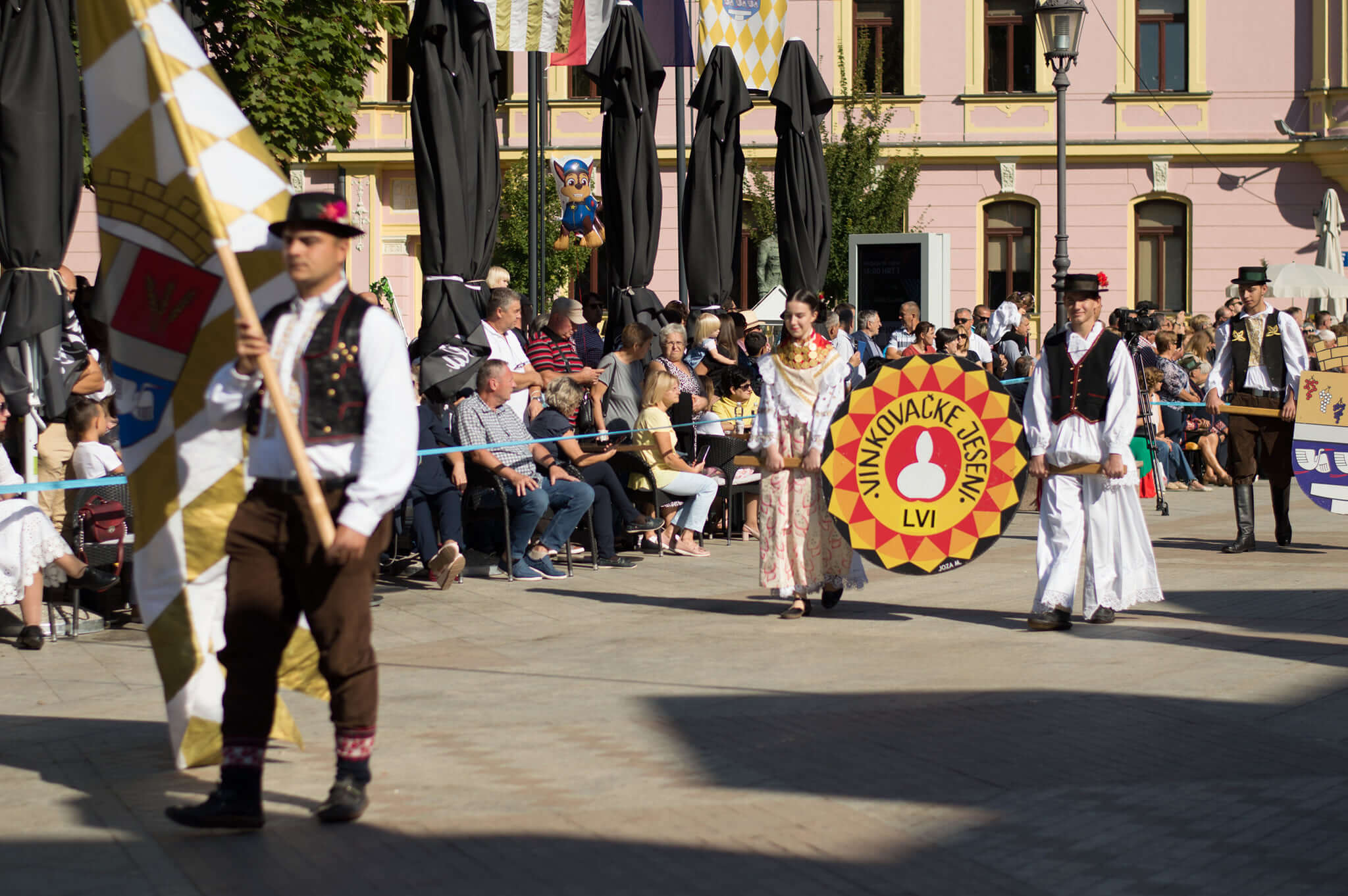
"Vinkovačke jeseni" parade - the main event on the last day (photo credit: Vinkovačke Jeseni - Facebook page)
Aurea Fest - Zlatne žice Slavonije (Golden Wires of Slavonia) - Požega
In the middle of Slavonia lies the city of Požega, located in the hilly parts of the region where none of the roads are straight - a place where hills are dotted with roads. Surrounded by the old hills of Psunj, Papuk, Krndija, Dilj, and Požeška Gora and home of the famous Croatian poet, Dobriša Cesarić, it doesn’t seem odd that this city is the home of one of the biggest traditional, cultural and musical events of folklore, tamburitza but also pop music, which has been held in Požega since 1969, with a break between 1981 and 1990. Zlatne žice Slavonije today is a four-day event with more than 40,000 visitors and more than 100 accredited journalists from several countries. Songs, top-tier wines, gastronomy events, concerts, exhibitions, art colonies, sports competitions, folklore festivals and other events are slowly making Požega and the Golden Valley one of the tourist destinations in Croatia in September. It hosted multiple Croatian musicians (mostly “tamburaši”) like Gazde, Zlatni Dukati, Miroslav Škoro, Slavonske lole and so many more. CDs and cassettes were pretty popular back in the day, which meant that almost every Slavonian household had a copy of musical repertoire from Golden Wires of Slavonia! So, if you visit Slavonia, definitely visit Požega in September - great content, songs, dances, food, and most importantly, people. The main event, the concert, is nationally televised on HRT every year. For more information, visit their official page.
For now, we’re stopping here. There are a lot of traditional festivities in Slavonia but these three events are staples of traditional festivities in Slavonia and the whole of Croatia. From entertainment to food and sports recreation, these manifestations are unmissable events if you want to visit Slavonia. Slavonian spirit cannot be recreated anywhere else, so if you want to relax further after a summer tour of the Adriatic, come to Slavonia, they’re going to welcome you with open arms.
For more, make sure to check out our travel section.
"Biblical" Bird Invasion Devastates Slavonian Fields, Farmers Desperate
April the 4th, 2022 - There is a plague of birds that is biblical in a way taking place over the rich Slavonian fields, with farmers and others in the agriculture sector scratching their heads as to what to do. All common means of deterring the birds are failing, and some are ready to start killing them.
As Poslovni Dnevnik writes, Slavonian farmer Darko Grivicic painfully stated that he feels as if he's walking around in a desert, and not in the usually rich and fertile Slavonian fields.
He sowed an ecological feast last autumn, and now his fields look like the Sahara, reports HRT. All of what he planted has been destroyed and eaten by wild geese and cranes, and there is devastation on all sides. The problem this year, according to Darko, is even bigger because of climate change. Darko's field isn't the only one that was ravaged by wild geese. Berislav Stefancic from Radovanje has had around 50 hectares of young crops consumed by birds.
The birds are omnivorous
“These are mostly omnivorous birds, except for the grey wild goose, which is a herbivore. At the pond, they have a good feeding ground as far as fish, snakes and frogs are concerned, and here is their salad in our fields. They eat mainly winter crops - wheat rapeseed oil and the like. We haven't sown those in this area for the last two years because the damage they cause is terrible,'' said Berislav.
Wild geese come because there are huge fishponds in nearby Oriovac, and an ornithological reserve for spoonbills has been declared there. From year to year, said Iva Ivezic from nearby Radovanje, more and more of these birds come, meaning that the damage to these crops is increasing.
"Every year the problem is getting worse and every time I come to the same question - These birds are protected, but who is working to protect us? This year, an extremely large number of birds have appeared that we can't seem to deter or stop. We can't see how we can solve this problem,'' emphasised Iva.
Farmers on duty, firecrackers, drones - nothing helps
Local farmers have tried everything they can imagine, testifies Josip Culetic from Slavonski Kobas, who has had about 70 percent of his crops eaten by birds. Scarecrows, farmers on duty, he's tried everything. He says that one can be on duty out in the Slavonian fields for 23 hours per day, and when you go home for lunch, the birds arrive and do their damage in the span of just five minutes.
"We've chased them away with drones, but the birds only moved within a kilometre or two. It's a viscious circle, they don’t give up at all. At one point, they gathered and headed for the drone, trying to attack it. They aren't stupid,'' added Berislav Stefancic.
Darko Grivicic added that they threw around a million firecrackers and rockets trying to drive away the birds, but they failed even with that harsher measure. Darko went a step further. For about 20 thousand kuna, he bought and deployed 11 gas cannons, but it didn't help much. He believes that these tenacious birds would get used to even 30,000 cannons.
“When we sow grain, they immediately land and take out the seeds. We put out the scarecrow, we come and stand around, and they're brazenly standing on the scarecrows. They have become immune to all our measures,'' added Iva Ivezic.
Local hunting associations are also powerless because hunting protected birds is prohibited, with the penalties for doing so being absolutely astronomical. Whoever kills such a bird pays a fine of up to 30 thousand kunas Darko Grivicic said that the situation is unsustainable, and so far, the birds have eaten 3 million kuna out of his pocket.
Some are already sick of the damage and are ready to poison the birds
Some local farmers are losing patience. Darko Grivicic testified that people are increasingly threatening to bring poison in from Bosnia, mix it with cereal and corn and scatter it across Slavonian fields.
"Facirol is an agent that can be mixed well into corn or grain and then scattered on the roads. I believe all the geese and cranes would die if they consumed it. The only question is where they die. If they die in the ponds, they'll probably poison the resident fish as well. If someone catches that fish and takes it home there is a possibility that we end up accidentally poisoning people. But it has to be said that this is an option that some people are ready for, if nothing is done,'' claims Darko.
Slavonian farmers are now busy working on and announcing millions of lawsuits against the state that they claim is doing absolutely nothing to protect its own food producers.
For more, check out our lifestyle section.
Planting Traditions in Slavonia: What Slavonians Like to Cultivate
4th of April 2022 - From Saint Patrick's Day, which is on March 17, Slavonians usually start planting crops for various reasons - for personal use, animals, and more. The planting season in Slavonia has thus begun, and we're taking a look at planting traditions in Slavonia.
Saint Patrick’s Day doesn’t hold particular importance in Croatia, except for the name day that people with a similar name celebrate. However, in Slavonia, this day marks the start of planting the crops that will be available for harvesting, and furthermore, some of those products will be stored for winter. Crops don’t have to necessarily be planted specifically on St. Patrick’s Day but after that date, people hurry to sow their plants before the rain. Why does it need to be done before the rain? For a simple reason - when rain occurs after sowing, the seeds will swell and the beginning of the growth process is in motion.
That is only the “first round” of the planting since not all plant crops can be immediately be planted. These next vegetables are most common in the “first round of planting”.
Potatoes
A useful vegetable that can be used in many ways and because of its flexibility and endurance during its growth, this plant is unavoidable in Slavonia. Potatoes from Lika are one of the most famous Croatian products. When planting, people make rows in their gardens that are approximately 25 centimeters deep and start putting potato tubers with sprouts, one by one, one foot away from each other (you can measure distance with your foot) and later buried with a hoe. Red and white potatoes are the most prominent ones and are planted for different uses - red potatoes are good for frying and roasting, and white ones are for boiling and cooking. People who don’t have big gardens or lands can also plant on their balconies or small spaces indented for planting.
Onion
Onions with potatoes are in the same tier of importance for Slavonians and have mostly the same attributes. Flexibility in its handling in the kitchen and mostly pretty endurable, this crop has many good uses. However, there is a problem that, of course, can be avoided. The danger of rotting is pretty common with this plant (which can be also said for potatoes but in smaller measure) and if not harvested on time, this is an unavoidable problem. Why? Well, when harvested, our ancestors would leave onions on the field to dry but with climate change and far harsher summers, they’re usually put under the canopy or whatever place where the sun isn’t blazing hot. Onions planted in March are usually ready for harvesting in July but even “young” onions are good for use, especially at Easter time.
Carrots and parsley
An indispensable part of any stew or soup, these two plants are really an important part of planting traditions in Slavonia. It is also harvested in July but has multiple uses besides its root. For instance, parsley’s leaves are put in the meals as a spice and it is present in almost every Slavonian meal - čobanac, gulaš, fiš, and many more. Carrots, on the other hand, can be consumed young as onions - roasted young carrots coated in butter equals a great summer meal. One more plant that can be cultivated in small and closed places.
Garlic
This plant has, so to say, a mythic reputation in multiple cultures including Slavonia. From having healing attributes for stomachaches, strengthening immunity, and so on, to flexible uses in the culinary world. If any ingredient symbolizes Slavonia, that’s definitely garlic - spicy, strong smell and certainly a food that enhances every meal. Planting is the same as is with onions - bulbs are put in the ground and just gently covered with soil. A very durable plant that can withstand any weather and be usable all year. It can be cultivated anywhere.
Celery
Its head is mostly used for meals but the culinary internet revolution discovered newfound use for its leaves. They can be put in the pesto, carbonara, or just a sauce ingredient for extra flavor. Celery heads in Slavonia are used as an ingredient for soups and stews like previously mentioned gulaš and paprikaš. It can be stored for later use and its durable ingredient is why this plant is part of cultivating and planting traditions in Slavonia. In recent years, it's also been used as a juice! Rich with sodium and vitamin A.
Red beet
Also planted in the first round of planting, red beet has multiple uses and is one of the healthiest ingredients on this list. Its juice is used in the fitness world for strengthening a person's fitness and body. Furthermore, it can lower blood pressure and increase blood flow. Rich with folic acid, manganese, potassium, vitamin C, magnesium, iron and so many more. Its root in Slavonia is used mostly for winter storage, namely, pickled in glass jars. “Soily” taste and beautiful color make this ingredient an important plant in the Slavonian region.
Peas and string beans
These two at first glance seem the same but they’re not. Even though they’re from the same family of plants (legume or pea family), they can be used in different ways. Stews are probably most common in Slavonia for peas but string beans can also be prepared in salads or roasted with other vegetables. Their issue is that they’re really sensitive and require nonstop care. A great ingredient for various meals.
Those vegetables are most commonly planted in the first spring planting, however, a bit later in the spring season, seeds are replaced by seedlings, young plants that have already sprouted from their seeds. These include tomatoes, cabbage, swiss chard, broccoli, peppers, jalapenos, cucumbers, and many more. Cultivating from there needs to be on a higher level since these plants require more care which means more water, fertilizers, and fluids that protect the plants from harmful organisms - parasites. What’s also important to note is the importance of these crops, used and pickled for winter storage. Most common are homemade tomato sauce, pickles, so-called hunting salad, pickled pepper, mild and spicy, and many more.
If we look deeper, planting traditions haven’t changed much in recent decades. Proven methods from our ancestors still work, are even better than the modern ones we encounter today, and still feed generations of people in these areas. Every region in Croatia has its own traditions and that’s what makes Croatia so rich - whenever you go, you can see how Croatian people survived the toughest times and managed to use its resources in the best possible ways. Earth and ground we walk on are still one of the rare things that never let Croatians down and that’s reflected in planting traditions in Slavonia.
For more, check out our dedicated lifestyle section.
Poetry As Preservation of Slavonian Cultural Heritage and Tradition
31st of March 2022 - Meet Željko Čuljak, whose poetry and stories about the beauty of Slavonia and its residents aim to preserve the cultural heritage and tradition of his village Cerić and the whole Slavonian region.
We spoke with Željko in his home in the small village of Cerić, which is located near Vinkovci and has suffered a tragic fate. During the Homeland War, Cerić fell and was destroyed to the ground - residents lost everything and inevitably fled the enemy aggression which destroyed everything in their way. Željko, with his fellow fighters and villagers, stayed behind and helped to protect Nuštar, a nearby village that resisted tireless enemy attacks and led bloody battles that lasted for days. On the 5th of October in 1991, just a few days after surrounding villages fell to the enemy hands (Cerić and Marinci), Croatian defenders resisted enemy attacks and, in the end, managed to protect the village from aggressors. This event is forever inscribed in the history books of the Homeland War as the “Battle of Nuštar”, which was one of the biggest wins of the Croatian army in an effort to protect the country of Croatia from aggressors. Why is this event mentioned? Because its consequences left a big scar on Cerić and its surroundings - destroyed homes, displacement of the residents, destroyed the most recognizable symbol of the village, the church and so much more. The identity of the village was shattered by those buildings and still has an impact on the village's atmosphere today. However, returnees to the village and new residents made it their mission to bring back the old glory of Cerić, promote how people lived before the war, and show that their tradition, cultural heritage, and their lives were not erased on that fateful day in 1991.
Thus, join us in meeting Željko, who is at forefront of the mini “Slavonian revolution” which is propelled by his stories and poetry about the past and present and the future of Slavonia as well.
Željko, can you tell TCN readers a bit about yourself?
My name is Željko Čuljak, a folk poet and a writer, a defender of the Homeland War and a retiree, who in their free time raises pigeons and writes stories about Cerić and Slavonia. I am a father of three children, a grandfather, and a husband. My writing is connected to the exile of our village, ten years of watching my village from the frontlines. To understand my writing and me in general, you need to see where I live.
What is Cerić? If you look at it as an outsider it seems like any ordinary Slavonian small village, so what is so special about it to you?
We live in Slavonia, a rich and “full” region that through time attracted a lot of conquerors and consequently, misfortunes. People who lived here suffered a lot during a few wars that happened in this region and after those casualties, the number of residents rapidly decreased which led to people all over the country migrating to Cerić. In the beginning, a lot of conflicts occurred between immigrants and the old residents, who felt threatened by the newcomers. However, after some time, harmony and love prevailed and connected these different groups. Love won in the end and those newcomers accepted the village's customs and cultural heritage and traditions of this region. In conclusion, calm people live here.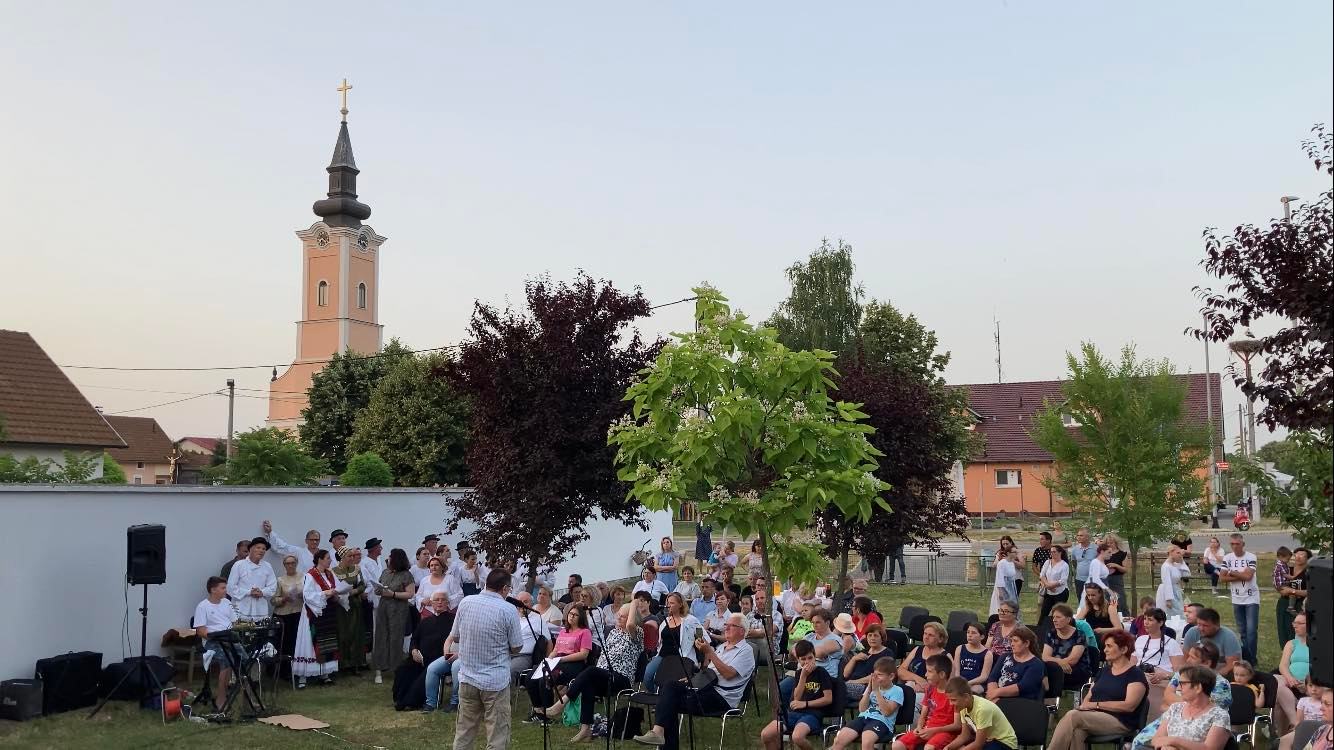
"Evenings with Poetry" in Cerić, (photo credit: Vedran Čuljak)
When did you discover your passion for writing?
I don’t talk much, a lot of the things I prefer keeping to myself and we were taught “if you don’t have anything nice to say, it’s better for you to be quiet.” I endured the war better while I was in it than when I came back to destroyed homes and a neglected village, it fuels the anger in you. That site slowly but surely built up anger and rage in me and I couldn’t express it to others nor me. Then, one time at the mass, I heard a priest talking about anger and saying: “Love your enemies, forgive!” How can I do that?! I realized that I need to forgive myself to let go of that anger. When I’m surrounded by so many good people, how can I be angry?! And those experiences fueled my inspiration for writing. Firstly, I started writing for myself. I write about the beauty and happy adventures of our lives and their residents. I felt sorrowful for not sharing my work with anyone, so I started gifting and selling my work to family and friends. When they liked and praised my work, I felt like I was doing something right. Also, I am part of the Folklore Society of Cerić "Slavko Mađar" and they always need new ideas or “old” ideas I realized that war kind of erased part of our history, people who “disappeared” from this place took the tradition and cultural heritage with them. Today, I’m sort of a keeper of memories in Cerić, one of the people who bring those old stories and memories back to residents and it, unfortunately, seems that people forgot most of them. I try my best to save and preserve that cultural heritage for children of the future. We have a very nice combination of us poets who write and the rest of the village who “absorb” everything we make. We give our poetry soul and actors from Folklore give them life.
Željko, do you think there are enough of these initiatives that have the mission of preserving and promoting Slavonian cultural heritage?
Folklore Societies are keepers of tradition and it’s well represented, not just in our region but throughout all of Croatia. Every village and town have their own Folklore Society. The question is, are people aware of them? Once upon a time, people were actually running away from tradition and it was an embarrassment to even be connected to these groups because everything else foreign was better. Then we realized during War that we miss sitting under the old mulberry tree while the spring sun is shining, harvesting our own crops and so many more things that make this region unique. Simply, all of the residents of Cerić realized that that’s the point - it’s nice to go abroad to a beautiful country or city but in the end, there is no place like home.
Do you have any of your original work published?
I have a collection of poems called Trace of The Soul (Trag Duše) which came out in 2019. It’s mostly poems about the war we experienced, adventures, and traditions Cerić offered and inspired me to write about. I wrote another book of poetry expected to be published near the end of the year, it should’ve been published before but COVID-19 slowed down the process. It’s easy to write for me since there’s a lot of inspiration around me like children going back from school, the boy who’s a head shorter than the girl but still carries her bag, and those kinds of stories make my writing worthwhile. Everything is simple and lively in this village.

Original cover of "Pattern of the Soul" (Trag duše), Željko's published work, (photo credit: Vedran Čuljak)
Who’s your biggest critic?
My wife is my eternal inspiration to me haha AND my biggest critic of course. Everything that works and everything that doesn’t work she always tells me. She knows how to read my poem better than I! I don’t know how to interpret it when I write it! To me, it’s a blessing and brings me a lot of joy when every poem finds its own role, every person finds themselves in my poem, my story. We are extremely lucky that our whole village participates with us.
Can you tell us the events or manifestations that you organize every year in your village?
We have “Evening of Poetry” which is usually held during summertime at the end of June. It’s part of the celebration of our saint of the village, Ivan (John), or how we say it here, Ivanje. Usually held in the evening, residents gather and light up the torches, we sit on bales of straw in the middle of Cerić and recite our poems and stories. Residents and our guests also participate in the event and it’s such a beautiful celebration of Slavonian cultural heritage and traditions. We have one more event, the “Yearly concert of Folklore Society” which is held around Municipality Day of Nuštar. Local people criticized this manifestation since it was held on 2nd of the October which was the day Cerić fell in the Homeland War. We were accused of celebrating the biggest tragedy this village experienced in its history. What they didn’t understand is that we always celebrate life, coming back to our homes, all of those people who were exiled or have left us for other reasons and we do it with songs, socializing, being happy and that’s the most important part.

One of the manifestations celebrating the cultural heritage of Cerić and Slavonia, (photo credit: Vedran Čuljak)
As we know, Slavonia lost a lot of its residents in recent years, do you think that factor will affect your manifestations?
I don’t think so. Residents of Cerić notice our work as our guests as well. For example, we had a group of school children coming to our village as part of their trip, it was some kind of Vinkovačke Jeseni program and let’s just say the children weren’t that positive coming here. Why? Because they didn’t know what Cerić is, never heard of it and of course, they’re just not interested in those places, what can Cerić offer to them? However, after we hosted them nicely, organized nice lunch, their teacher, who was in charge, told us that this is the first time in her career that the children didn’t want to go home, they didn’t want to enter the bus and go. I know it’s a small sample but everyone who comes here, goes back home happy and they come back every year. There is still interest and to me, it seems it’s growing in the last few years.
Does that mean that there are successors and willing children to continue doing what you started? Promoting and persevering Slavonian cultural heritage?
Definitely! More and more children realized villages' worth, their traditions, and cultural heritage. Cerić and its residents are unbelievably close and connected, while other villages talk about the alienation of their residents from their heritage, we prosper every year more and more. When a child puts on our traditional folk costume (šokačku nošnju) and when you look at the photos of their ancestors in the same costumes, those children are vivid pictures of their predecessors, great grandmothers, great grandfathers, only the hair and clothes changed. Everything stayed the same. There are successors and always will be. They will never disappear!
Thank you Željko for your time! Can you recite one of your original Slavonian poems for the TCN readers?
From the poem "Slavonia, Mother"
"When I leave my homeland at dawn
I carry in my eyes a memory far from
far from the eye, to the heart, it's also hard
I will return once through tears, I said
.....
We'll meet again under the old oak
when the years close my dreamy eyes
until then I love you and always think of you
in my dream, almost every night I dream about you."
Events celebrating Slavonian cultural heritage mentioned in this interview are held in Cerić on the 24th of June "Evenings with Poetry" and the 2nd of October "Yearly Concert of Folklore Society "Slavko Mađar". If you're ever close and for instance, ever come to "Vinkovačke Jeseni", visit Cerić and their events, Slavonia, as always will welcome you with open arms.
For more, check out Made in Croatia.
Festivities in Eastern Slavonia: Things To Do in Spring
18 March 2022 - Spring is on the horizon! Ceremonies and events are slowly but surely moving outdoors and since TCN already covered “Five Places You Must Visit During Spring in Croatia”, this is a look into what festivities in Eastern Slavonia are happening during the new season.
Firstly, we need to start with the biggest city of Eastern Slavonia - Osijek. As usual, the greenest city in Croatia has various events that can fulfill any person's preferences: from music, film, theater, and traditional events to sports and other activities that include all of citizens and guests. Since there is no shortage of events this spring season, we had to single out a few that will happen soon. It doesn't hurt to mention again that Osijek is going to host the 29th Porin Music Awards on the 25th of March. For more details, check the article here.
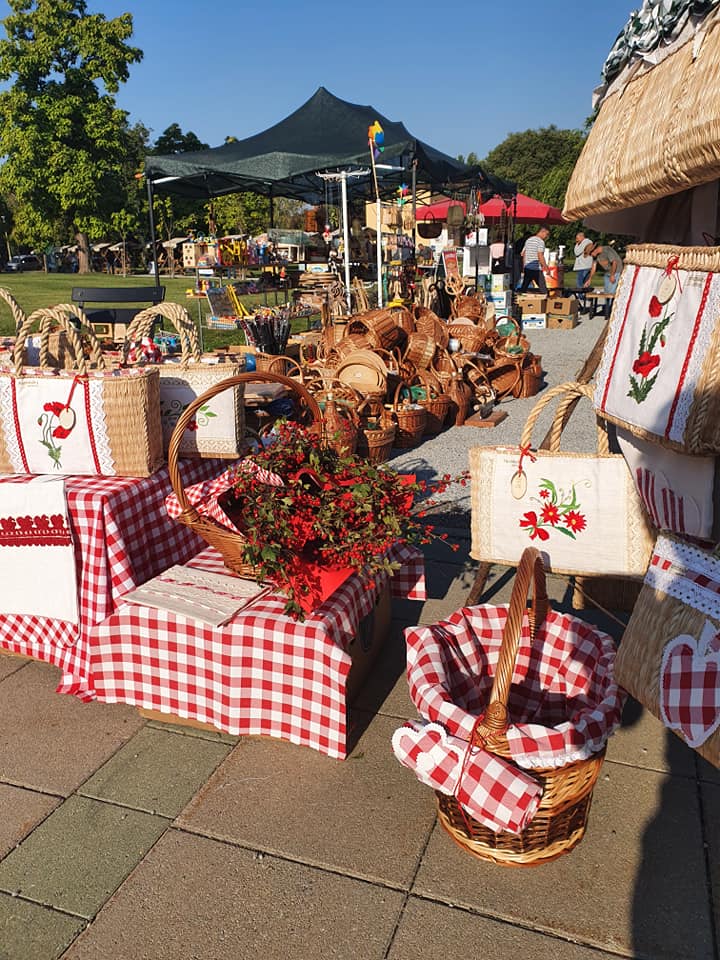
Antiques Fair, (Photo:Okusi sreće by Pavica/Facebook)
Antiques Fair - 2nd of April
The citizens of Osijek love their culture and heritage so it’s not surprising that the Antiques Fair is one the most popular events in the city. From old gramophone records to lost books and masterpieces from local unknown artists, this festivity is for everyone. Excitement as you pass by a sea of stalls that potentially contain a lost “treasure”? It is guaranteed only at the Osijek Antique Fair that is usually held on the first Saturday every month in the Old Town of the city - Tvrđa. However, the next Antique Fair will be held in King Držislav Park near the famous urban statue The Shell (Školjka) on the 2nd of April. The Park is located just across from Tvrđa, so it is not hard to find it. You can check for more here.
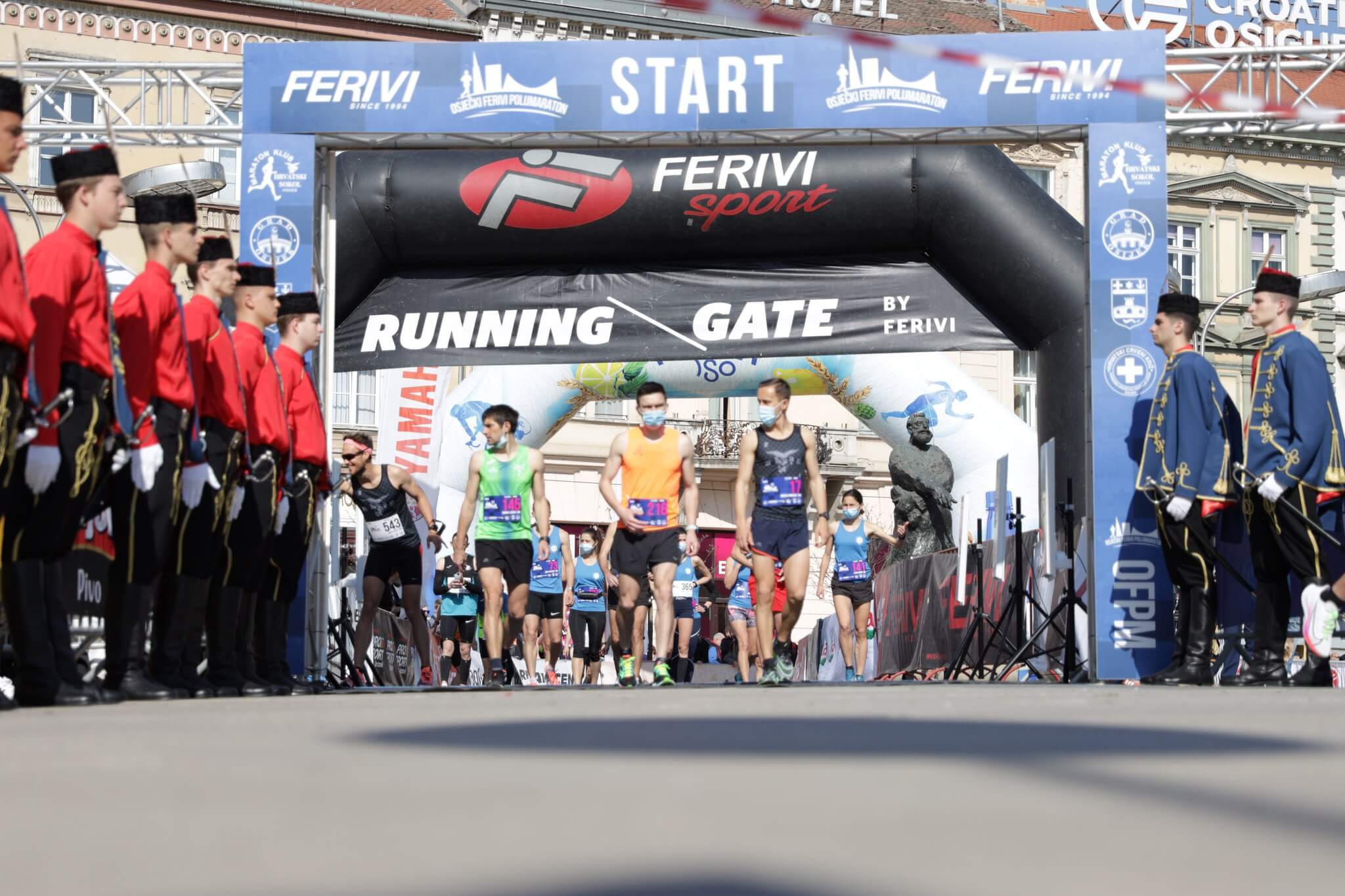
Osijek Ferivi Half Marathon (Photo Osječki Ferivi Polumaraton/Facebook)
18th Osijek Ferivi Half marathon - 9th of April 2022
This event, as the name suggests, will take place in Osijek, with four different races included: a half marathon (21.1 km), relay (3 x 7 km), citizens’ race (5 km), and a race for the youngest - children. These events will be accompanied by a music festival, instrumental, dance, and singing groups with a goal to entertain the visitors and competitors. Since its foundation, Osijek Ferivi Half Marathon has had an increase in the number of participants every single year and it’s becoming one of the biggest sporting events in Osijek and its surroundings. If you’re interested, the application is still open for everyone - it doesn’t matter if you’re a professional or casual, everyone is welcome!
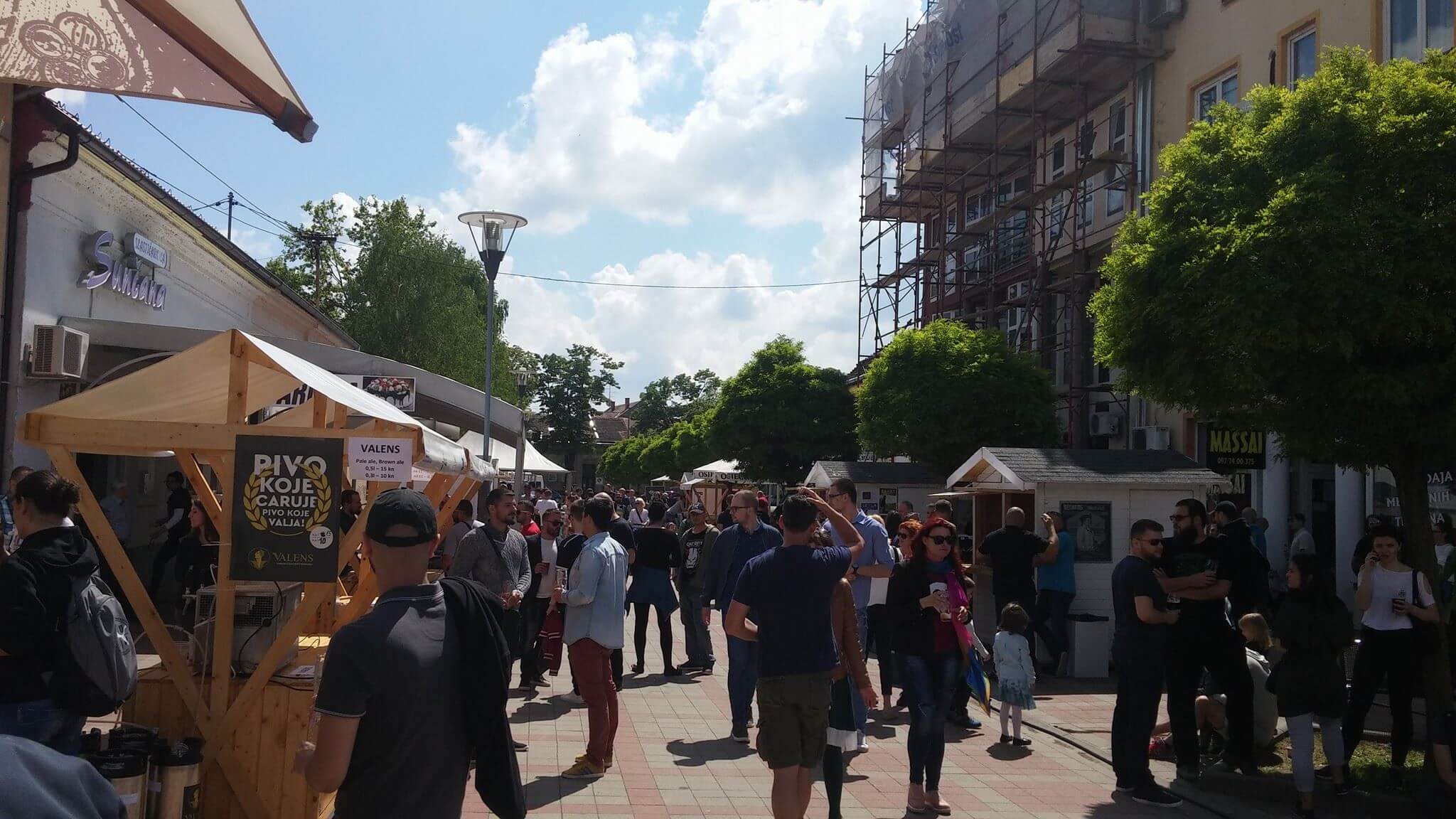
Craft Beer Festival in Osijek (Photo: Osijek CRAFT BEER Festival/Facebook)
Craft Beer Festival - sometime in May (to be determined)
How can Spring pass in Osijek without an event for beer lovers? In the last decades, Osijek has become a center for beer connoisseurs, not only in Eastern Slavonia but for beer enthusiasts all over Croatia. This fact is not surprising at all if we take into account that Osijek is also a center of multiple small breweries that produce various types of beers which have become iconic for this part of Croatia. Craft Beer Festival has been held last year during June but this year it’s probably coming back to its original date in May. We still don’t know the exact date. Nevertheless, the event will come back to the famous so-called “beer street” - Sun Street (Sunčana Ulica). For updates check their Facebook page.
If you’re interested in breweries in Osijek, check an article from our intern Toni.
After Osijek, we go further East and present cities of Vinkovci and Vukovar. Two historical Slavonian cities have a lot to offer with the support of surrounding small towns and their own events that enrich the lives of locals in Vukovar - Srijem County.

Flower Festival in Vukovar (Photo: Miroslav Slafhauzer/Turistička zajednica grada Vukovara)
Flower Festival - end of the April
Flower Festivals are a common event in Slavonia (we already had one in Osijek during Women’s Day). At the end of April every year, a Flower Festival is held in the center of Vukovar which brings together local and regional plant growers, florists, arrangers, related craftsmen, and lovers of flowers and ornamental plants. The Fair has sort of an exhibition and sales character which gives a completely different, colorful, and warmer look to the center of Vukovar. This event is also an overture for marking City Day.
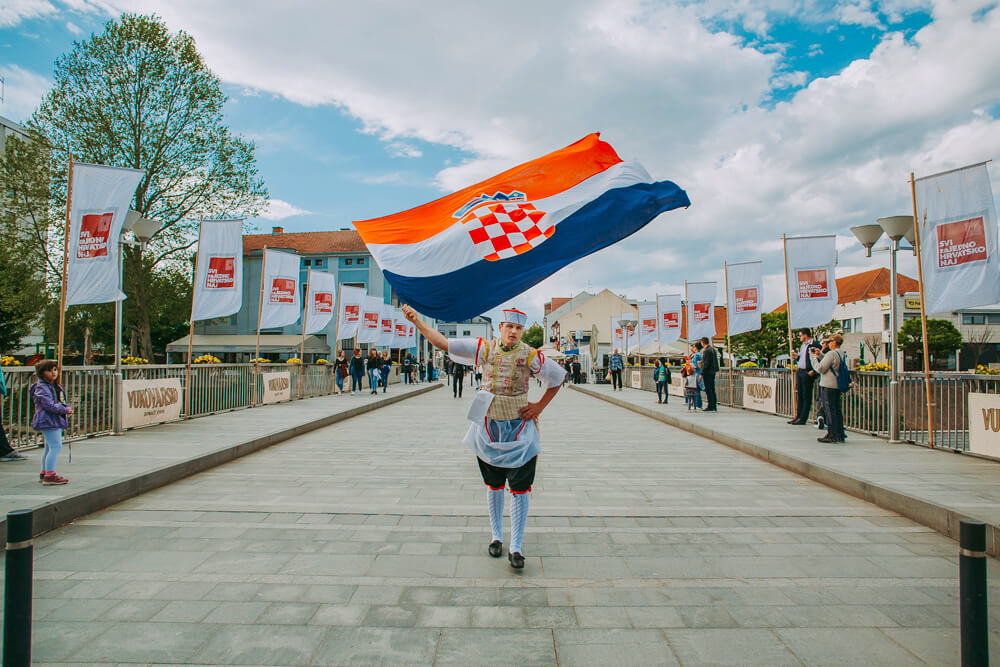
Svi zaJedno Hrvatsko Naj Festival in 2019 (Photo: svizajedno.eu/Galerija)
Svi zaJedno hrvatsko naj - cultural and tourist event - part of Vukovar City Day, 3rd of May
This festival is fairly new - it was firstly held in 2018, as a part of the European Year of Cultural Heritage. Its uniqueness lies in the fact that it is the first Croatian festival to present protected Croatian intangible cultural heritage on the national and UNESCO list with the most attractive tourist events, attractions, and destinations from all over Croatia. During the event, visitors have a chance of exploring various manifestations held all over Croatia by tasting autochthonous Croatian dishes and enjoying the offer of the best Croatian wines. Of course, what would be a Slavonian event without traditional music and dance groups? For more details, you can check their website.
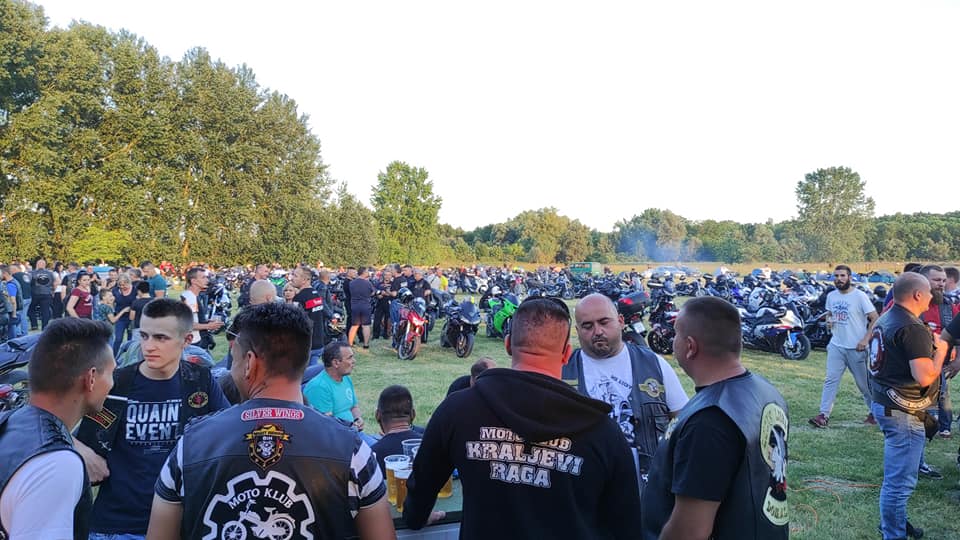
"Motorijada" in 2021 (Moto Klub Županja/Facebook)
Motorijada by Moto Club Županja - 10th of April
Motorijada (Moto Race) is an event that is organized by Moto Clubs all over Croatia. Motorcycle enthusiasts organize these events to promote, among other things, motorsports and use this opportunity to meet with their fellow motorcycle buddies. This April, Moto Club Županja is organizing the 16th Opening of Moto Season of Vukovar - Srijem County with the aim of drawing the attention of other road users to the presence and safety of motorcyclists in the traffic. They will start their tour in the village Rajevo Selo and go through multiple towns in Vukovar - Srijem County with the ending in the host city - Županja. Everyone is invited and if you’re a motorcycle enthusiast or just love looking at the motors, this is a great event to visit. For more information, check their Facebook page.

Logo of the Festival (photo: Festival Glumca/Facebook)
Actor’s Festival - all cities of Vukovar - Srijem County, 13 - 22 May
The festival was founded in 1994 by the Croatian Society of Dramatic Artists and Vukovar - Srijem County and it is the only festival in Croatia dedicated to the actor and their artistic work. Today, this event has grown into a festival that brings chamber and large ensemble performances to the audience. If you’re interested in the festival full of character, good acting, acting personality, talent, and originality, visit Vukovar - Srijem County from 13th to 22nd May this year. Every city will have its appropriate events surrounding this festival. For more, check their official website.
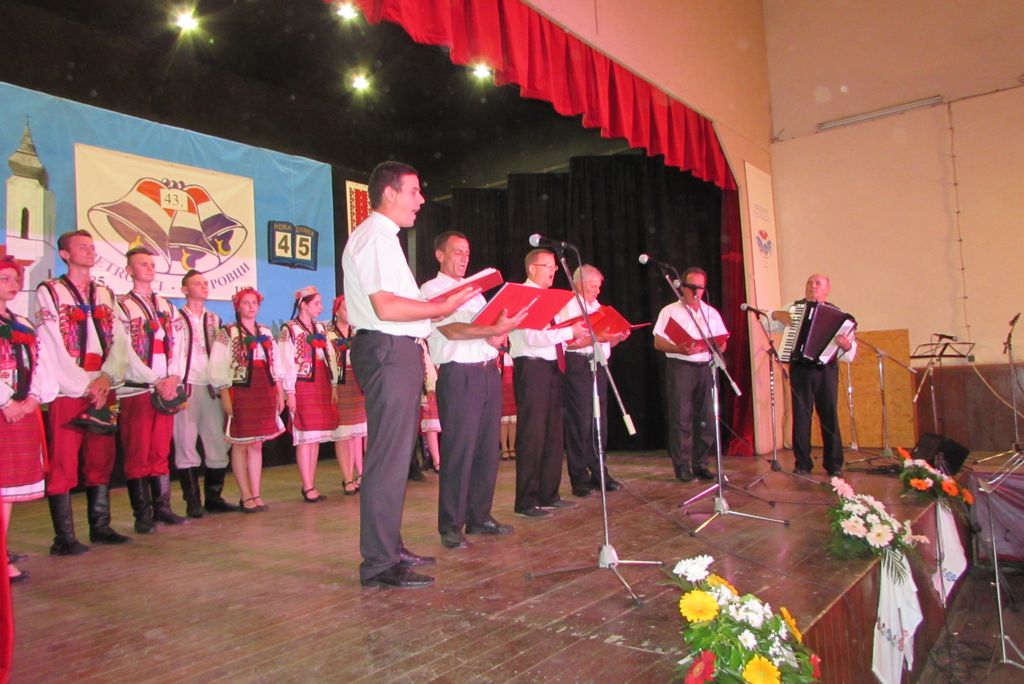
Petrovačko Zvono event few years ago (photo: savezrusina.hr)
Petrovačko Zvono - sometime in June, 49th edition
Rusyns are a national minority in Croatia with most of the residents residing in the village of Petrovci, which is located near Vukovar. Tradition, heritage, and constant maintenance of their culture for more than 40 years made this event one the most important in Vukovar - Srijem County. Rusyns from all over Croatia and other countries, visit Petrovci to connect to their fellow Rusyn people. They have a strong connection to Ukraine and their people, so if you’re nearby, visit this event, learn about the traditions of the people who’ve chosen Croatia as their home, and enjoy Petrovačko Zvono and its celebration of their heritage. For more details, you can visit their website here.
This is it for now. There are a lot more events that need mentioning, however, this article won’t be enough. TCN will bring you stories from some of these events and part two of places to visit in Eastern Slavonia is already on the way. Stay tuned!
Make sure to check out our dedicated travel section.
Women's Football in Croatia: Origins and Status Today
14 March 2022 - Women’s football in Croatia has gone through many changes throughout its history - from being solely a man’s sport to becoming one of the most popular for women worldwide. However, in Croatia, women's football still hasn’t received the traction it has in other countries, and many clubs, especially in Eastern Slavonia, saw an inevitable end. Why has this been happening, and what are the solutions to bring back the lost talents in women’s football? A look into women’s football in Croatia.
Women’s football has had many ups and downs throughout history. From being dismissed as only a man’s sport to its “golden age,” the ban that stopped the sport's progress and, in the end, one of the most significant rises in popularity of any sport in history. The “golden age” occurred in England at the beginning of the 20th century when British men were deployed and sent to the frontline during WWI. According to a BBC Three article from 2016, by 1921, there were around 150 women’s teams in England. A Boxing Day match in 1920 drew in crowds of nearly 70,000. However, after the war ended, women were pushed back to their “places” - closed in the houses to be housewives. In 1921, the “ban” was established, declaring it to be “quite unsuitable for females and ought to be encouraged!”. This “rule” was not lifted until 1971, and unfortunately, the damage has already been done.
If we compare Croatian women’s football history from that timeline, we could say it’s been a bit different. However, even though that sort of ban hasn’t occurred in the established Kingdom of Serbs, Croats, and Slovenes and later the so-called Kingdom of Yugoslavia, reservations about women in football were emphasized a lot. According to Grgic and his article “A Brief History of Women’s Football in Croatia/Yugoslavia in Between War Period,” football was generally open to both sexes. However, “experts” pointed out that women as sentient beings do not need to seriously follow men in sports because those who do it turn into masculine people. Throughout the article, Grgic also mentions multiple instances where football was solely considered for men, and women can only use it as a prop to “get into shape and take it easy because women are fragile.” This puts a lot of factors in perspective if we consider that communist countries (especially after WWII) like Yugoslavia set a significant emphasis on women's rights and their “rightful” part of the “revolution.” Still, even that couldn’t stop discrimination against women. But, once again, that didn’t stop women from playing football. For instance, ŽNK Dinamo-Maksimir is a Croatian women's football club based in Zagreb, and the club was founded as ŽNK Maksimir in 1937. The Yugoslav First Women's League was active between 1974 to 1991 and the fall of Yugoslavia. Zagreb, later called Maksimir, was the only Croatian club in the League, and the club with the most titles was Mašinac from Niš.
After the Homeland War, many Croatian women’s football clubs were founded, which led to the eventual establishment of the Croatian Women's First Football League formed in 1992, following the dissolution of the Yugoslav First Women's League, which is currently underway and features eight clubs.
However, in recent decades, women’s club popularity has not helped the sport's popularity in Croatia, especially in regions like Eastern Croatia. Yes, ŽNK Osijek is the most successful Croatian club in the country, but it didn’t help the inevitable shut down of multiple women’s football clubs, especially in Vukovar - Srijem county.
For instance, out of ten active women’s football clubs in the last two decades, only five of them stayed active with ŽNK Mikanovci, NK Dilj Vinkovci, and Graničar Županja mainly operating in Croatian Women’s Second League. The rest of them work only in younger categories. Displacement of the population, lack of children, and girls' disinterest in the sport made clubs shut down. Girls who wanted to play football had to go to other towns and clubs that were still active, and the best would go to ŽNK Osijek.
Also, most Croatian women’s football clubs pay miserable salaries to their players who are just too low for today’s living standards, whereas in lower league clubs' wages are just non-existent. However, in recent years there has been progress, namely in the infrastructure of the Leagues and clubs, possibilities of the clubs to pay to their players, and constant promotion of women’s football games. It made everything so much easier because of social media and an overall rise in the sport's popularity internationally.

Out of ten clubs, five of them shut down in recent years, and the rest of them are mainly operating in younger categories - Screenshot: Wikipedia
*ugašen (shutdown) *djeluje u mlađim kategorijama (operating only in younger categories)
After the ban was lifted in the UK, women’s football finally progressed. Leagues and football clubs were founded, and the first World Cup in 1991 in China was finally held. In recent times, FIFA World Cup in 2015 and 2019 reached new heights in popularity and brought unprecedented ratings, which could be compared to Olympic Games. Women’s football is now a rapidly growing sport that finally started getting an influx of money and popularity long ago.
Croatian FA recently joined the UEFA Playmakers program, which was created with Disney. The project's primary goal is to introduce football to girls aged 5 to 8 who never experienced playing sports. The program will take place in 2022 and 2023, and four editions will be organized. The first edition - in March 2022 - will follow the animated film Frozen 2. The training will take place on the fields and/or in the halls of women's football clubs so that girls can join the clubs and continue playing football after participating in the UEFA Playmakers program. This project will also include cities all over Croatia and help promote the sport to girls across the country.
In conclusion, after everything researched, we can say that the rise of women’s football in Croatia is inevitable. Of course, it will take a long time since nothing can be done in one day, but positive times are here. Croatian Women’s Football Leagues are slowly but surely developing talent. The Croatian National Team is playing in playoffs for multiple big tournaments, and I don’t doubt that they will one day qualify. The interest in the game is rising again - even though many clubs shut down, girls are once again willing to play football, and rightfully so, because it’s our game too - a women’s game.
To read more about sport in Croatia, follow TCN’s dedicated page.


